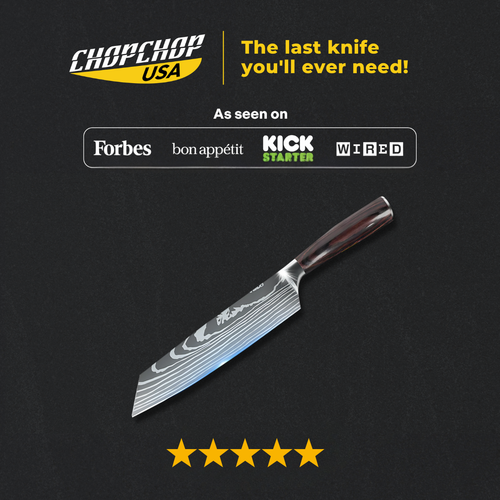How to make stainless steel cookware last a lifetime? Proper care, usage, and maintenance are key. While durable and non-reactive, neglecting certain practices can shorten its lifespan or affect performance.
In this guide, ChopChop USA shares essential tips for cleaning, storing, and maintaining your cookware, highlights 12 common mistakes to avoid, explains optional seasoning, and provides practical advice to keep your stainless steel pans reliable and beautiful for years of cooking.
How to Properly Clean Stainless Steel Cookware

Cleaning stainless steel cookware correctly is essential for maintaining its shine, durability, and cooking performance. Proper cleaning prevents discoloration, corrosion, and surface damage while keeping your pans hygienic.
Daily Cleaning & Maintenance
- Wash After Each Use: After cooking, rinse your cookware with warm water and mild dish soap. Use a soft sponge or cloth to gently remove food residue.
- Avoid Abrasives: Do not use steel wool or harsh scouring pads, as these can scratch the surface.
- Soak Stubborn Food: For stuck-on food, soak the pan in warm soapy water for a few minutes before gently scrubbing.
- Dry Thoroughly: Always dry the pan completely to prevent water spots or mineral deposits and maintain its natural shine.
Deep Cleaning and Stain Removal
- Burnt-On Food: Burnt or stuck food can appear over time. Create a paste of baking soda and water or use a specialized stainless steel cleaner to remove it.
- Discoloration: Rub gently following the grain of the metal to restore the pan’s surface.
- Water Spots: White water spots can be removed with a vinegar and water mixture. Rinse well and dry thoroughly.
Longevity Tip: Consistently following these cleaning practices ensures your cookware remains functional, attractive, and long-lasting, reducing the need for unnecessary seasoning.
Seasoning and Oiling (Optional)

Do You Need to Season Stainless Steel Pans? Seasoning involves coating the pan with a high-smoke-point oil, such as canola or grapeseed, and gently heating it until it starts to smoke. Once cooled, wipe off excess oil. This process creates a light, temporary nonstick layer that helps delicate foods like eggs, fish, or pancakes release more easily.
When Seasoning is Helpful
Seasoning is most useful for brand-new pans with very smooth surfaces, which can initially cause sticking. It can also be beneficial when cooking sticky foods frequently, as it can reduce cleanup time.
Maintenance After Seasoning
Even if you season your pan, regular cleaning with soap removes oils, meaning seasoning may need to be repeated occasionally. Proper preheating, oiling during cooking, and gentle cleaning are usually sufficient for long-term performance.
Seasoning is optional and mostly cosmetic. It can enhance your cooking experience for specific dishes but is not required for the safety, durability, or overall performance of stainless steel cookware.
Storage Tips for Longevity

Proper storage is key to keeping your stainless steel cookware in top condition. Simple habits can prevent scratches, water spots, and damage over time.
Avoid Stacking Without Protection
Place paper towels, cloths, or silicone pan protectors between stacked pans to prevent scratches and friction damage.
Keep Pans Dry
Always dry cookware thoroughly before storing. Residual water can leave mineral deposits or water spots that affect appearance.
Store Lids Separately
Use lid organizers or store lids separately to avoid scratching the pan surface.
Don’t Store Food Inside
Avoid leaving food in stainless steel cookware for long periods, especially acidic dishes, to prevent discoloration or corrosion.
Organize for Easy Access
Arrange pans so frequently used items are easy to reach without knocking against other cookware. This reduces accidental damage and prolongs their lifespan.
Read more: Is It Safe to Store Pans in Your Oven Drawer?
12 Common Mistakes to Avoid
Avoiding common mistakes helps maintain performance, appearance, and longevity. Below are 12 practices to steer clear of to ensure your pans stay reliable and beautiful for years.
Cooking on High Heat Unnecessarily
Using excessively high heat can warp your pans, cause food to stick, and create discoloration. Most cooking tasks are perfectly done on medium heat. Preheating your pan gradually ensures even heat distribution and reduces the risk of damaging the cookware.
Using Abrasive Cleaners or Pads
Steel wool, harsh scouring pads, or strong chemical cleaners can scratch and damage the pan’s surface. Instead, use soft sponges, cloths, or a baking soda paste to safely remove residue without compromising the finish.
Adding Salt to Cold Water
Adding salt to unheated water can pit stainless steel, leaving small holes on the surface. Always wait until the water reaches a simmer or boil before adding salt to protect your cookware.
Leaving Water to Dry on Its Own
Air-drying can leave white water spots or mineral deposits, which affect the pan’s appearance. Always dry cookware thoroughly with a soft cloth after washing to maintain its shine.
Neglecting Handle Care
Handles can loosen over time if stressed or mishandled. Avoid dropping your pans or using excessive force when lifting. Regularly check for tightness and ensure handles remain secure for safe, comfortable use.
Storing Food in Cookware
Leaving food in stainless steel cookware for long periods can cause discoloration or corrosion, especially with acidic foods like tomato sauces. Always transfer leftovers to appropriate storage containers to preserve both the food and your pan.
Shocking Hot Cookware with Cold Water
Plunging a hot pan into cold water can warp or distort its shape. Allow cookware to cool slightly before washing to protect its structure and maintain optimal performance.
Using Excessive Cooking Spray
Some cooking sprays leave residues that discolor pans over time and make cleaning harder. Use a small amount of oil or butter instead for safe and even cooking.
Skipping Preheating
Preheating pans is essential for preventing sticking and ensuring even cooking. Heat your cookware gradually over medium heat before adding oil or food to create the ideal cooking surface.
Read more: 7 Best and 3 Worst Oils for Stainless Steel Cooking
Ignoring Manufacturer’s Instructions
Each brand of cookware may have unique recommendations for heat limits, cleaning methods, and maintenance. Following the manufacturer’s guidelines ensures you get the longest lifespan and best performance from your pans.
Forgetting to Deglaze
Failing to deglaze can leave stuck-on food that’s harder to clean and may damage the pan over time. Deglazing with water, stock, or broth helps lift residue while preserving the pan’s surface and flavor.
Using It on the Grill
Direct contact with open flames can warp or discolor stainless steel cookware. Stick to stovetops or oven use as recommended to maintain shape and finish.
By avoiding these common mistakes and following proper care practices, your stainless steel cookware will remain durable, functional, and visually appealing for years. With the right maintenance, your pans can become a long-term investment, providing reliable performance for every meal in your kitchen.
Investing in High-Quality Stainless Steel Cookware from ChopChop USA
Investing in premium cookware is key to longevity. ChopChop USA offers stainless steel pans built for durability, professional performance, and ease of maintenance. With proper care, these pans can last a lifetime.
ChopChop USA Stainless Steel Frying Pan

The ChopChop USA Stainless Steel Frying Pan is crafted from high-quality stainless steel for even heat distribution and long-lasting durability. Its smooth surface allows easy cleaning and optional seasoning. Ideal for sautéing, searing, and pan-frying, it works on all stovetops, including induction. The ergonomic handle provides comfort and safety, while the dishwasher-safe design simplifies cleanup. This pan is rated as one of the Best Frying Pans in the market.
ChopChop USA Hybrid Nonstick Frying Pan

The ChopChop USA Hybrid Nonstick Frying Pan uses a micro-engraved honeycomb stainless steel surface to create a natural nonstick effect without chemical coatings. Perfect for delicate foods like eggs, fish, or pancakes, it also offers even heat distribution and scratch resistance for long-term use. Oven-safe and compatible with all stovetops, it’s versatile for professional or home cooking. This pan is also rated as one of the Best Non Stick Frying Pans 2025.
Both ChopChop USA pans combine quality, durability, and design to minimize common mistakes that shorten cookware lifespan. Investing in these pans ensures that your stainless steel cookware will continue performing beautifully for years. Proper care, combined with high-quality materials, guarantees long-lasting results and a reliable cooking experience every time.
Read more:
- 3 Ply vs. 5 Ply Stainless Steel Cookware – Which is Better?
- Pros and Cons of Stainless Steel Cookware
- Are Scratches on Stainless Steel Pans Safe?
Conclusion
Making stainless steel cookware last a lifetime is achievable with proper care, cleaning, storage, and mindful cooking practices. Avoiding common mistakes such as cooking on high heat, using abrasive cleaners, and leaving water to dry on the surface preserves performance and appearance. Optional seasoning can enhance the cooking experience but is not required.
ChopChop USA’s Stainless Steel Frying Pan and Hybrid Nonstick Frying Pan provide high-quality, durable options that simplify maintenance and ensure reliability. Following these guidelines will help your cookware remain functional, attractive, and long-lasting, giving you a lifetime of exceptional cooking experiences.
For more amazing recipes, follow me on Facebook and Instagram! If you have any questions about ChopChop USA's products or promotions, please feel free to contact us at support@chopchopusa.com. Our dedicated team is available 24/7 and always happy to assist you.
Frequently Asked Questions
1. How should I clean stainless steel cookware to make it last?
Use warm water, mild soap, and soft sponges; avoid abrasives.
2. Do I need to season stainless steel pans?
Seasoning is optional and mainly cosmetic; proper cooking techniques suffice.
3. Can stainless steel cookware rust?
High-quality stainless steel resists rust, but prolonged exposure to moisture can cause spots.
4. Is it safe to use metal utensils with stainless steel?
Gentle use is fine, but wooden, silicone, or bamboo utensils are recommended to prevent scratches.
5. How can I prevent food from sticking?
Preheat the pan, use oil, avoid overcrowding, and allow food to release naturally.




